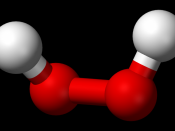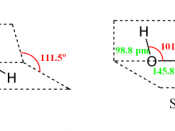Hydrogen peroxide has an acidic pH which will break down into water which has a neutral pH. This may effect the enzyme action as many enzymes work faster in a neutral environment, the only control over this is the fact that it will happen in each test and to consider its effect at the end of the experiment. I will need to use the same potato and cut a fresh chip at each stage of the experiment as the catalase may become effected by exposure to the air. This may effect results so I will keep the chips as similar as possible. The apparatus should have been washed with distilled water and I will use a different conical flask for each test so that any reactants left in a flask wont affect further tests. The procedure will stay the same so that the results can be compared.
Apparatus list and setup:
- Potato
- Potato borer
- Ruler
- Scalpel
- 6 conical flasks
- 20ml syringe (to hold enough hydrogen peroxide to cover the chip in the boiling tube)
- Double holed bung
- Retort stand
- Clamp
- Tongs
- Goggles
- 50ml glass measuring cylinder (to measure gas produced accurately and allow space for the displaced gas.
As the cylinder is larger than necessary I can take the next reading directly after the first without having to fill the cylinder as much)
- Bowl of water
- Hydrogen peroxide 20vol
- Splint
- Timer
- Delivery tube
- Tile
diagram
Method
1. Set up apparatus including filling glass cylinder with water and placing it upside down in water, measure width of potato borer and apply this to surface area formula
2. Read the level the glass measuring cylinder shows
3. Cut a piece of potato 4cm...


